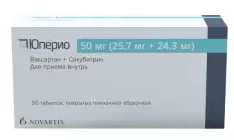Description
Valsartan Sacubitril (Uperio) Tablets Pharmacodynamics
Mechanism of Action
The action of Valsartan sacubitril (Uperio) tablets is mediated by a new mechanism, involving the simultaneous inhibition of neprilysin activity (neutral endopeptidase, NEP) by sacubitrilat (active metabolite of sacubitril) and blockade of angiotensin II type 1 receptors (AT1) by valsartan, an angiotensin II receptor antagonist (ARB II).
Under the influence of sacubitrilat, there is an increase in neprilysin degradable peptides, including natriuretic peptides (NPs). This, along with the suppression of angiotensin II’s negative effects by valsartan, leads to complementary cardiovascular and renal benefits in heart failure patients.
Natriuretic peptides (NPs) activate membrane-bound guanylyl cyclase-conjugated receptors, resulting in increased cyclic guanosine monophosphate (cGMP) levels. This leads to vasodilation, increased natriuresis and diuresis, enhanced glomerular filtration rate and renal blood flow, suppression of renin and aldosterone release, reduced sympathetic activity, and antihypertrophic and antifibrotic effects. Valsartan, through selective AT1 receptor blocking, counteracts the negative effects of angiotensin II on the cardiovascular system and kidneys, and also inhibits angiotensin II-dependent aldosterone release.
This prevents persistent activation of the renin-angiotensin-aldosterone system (RAAS), which causes vasoconstriction, renal sodium and water retention, cell growth and proliferation, and maladaptive cardiovascular remodeling.
Pharmacodynamic Effects
The pharmacodynamic effects of the sacubitril and valsartan complex were evaluated in healthy volunteers and patients with chronic heart failure. The observed effects aligned with the mechanism of action, with simultaneous neprilysin inhibition and RAAS blockade.
In clinical studies, the complex resulted in statistically significant increases in natriuresis, urinary cGMP concentration, and decreases in plasma concentrations of certain peptides associated with heart failure, compared to controls.
Indications
Valsartan sacubitril (Uperio) tablets are used in combination therapy to treat chronic heart failure (NYHA class II-IV) with systolic dysfunction, reducing cardiovascular mortality and hospitalization risk. They are used as substitutes for angiotensin-converting enzyme inhibitors (ACEIs) or angiotensin II receptor antagonists (ARBs) in heart failure treatment.
Contraindications
Uperio tablets are contraindicated in patients hypersensitive to sacubitril, valsartan, or other excipients. They should not be used with ACE inhibitors or for at least 36 hours after discontinuing ACE inhibitor therapy. Contraindications also include a history of angioedema related to ACE inhibitors or angiotensin II receptor antagonists, hereditary angioedema, severe hepatic impairment, biliary cirrhosis, cholestasis, and moderate to severe renal impairment while taking aliskiren.
Dosage and Administration
The dosing of Valsartan sacubitril (Uperio) tablets is independent of food intake timing. The target daily dose is 200 mg (102.8 mg + 97.2 mg) twice a day. The recommended starting dose is 100 mg (51.4 mg + 48.6 mg) twice daily. The dose can be doubled every 2-4 weeks up to the target dose.
In patients new to mineralocorticoid receptor antagonists (MRA) or ARA II therapy, start with 50 mg (25.7 mg + 24.3 mg) twice daily, increasing gradually. Uperio use must begin no earlier than 36 hours after stopping ACE inhibitors. It should not be used concurrently with other drugs containing ARA II.






![Extracts of dioscorea, clover, Omega-3 (Atheroklephyt Omega-3) kit 0.25 g + 0.7 g - [90 capsules]](https://mediscom.com.co/wp-content/uploads/2022/11/ATEROCLEFIT_OMEGA-3-90caps-100x133.webp)
![Atenolol 50 mg - [30 tablets]](https://mediscom.com.co/wp-content/uploads/2022/11/Atenolol-50mg-30-100x100.webp)
![Lappaconitine hydrobromide (Allapinin) 25 mg - [30 tablets]](https://mediscom.com.co/wp-content/uploads/2022/11/Allapinin-25mg-30-100x100.webp)
![Indapamide (Arifon retard) 1.5 mg XR - [30 tablets]](https://mediscom.com.co/wp-content/uploads/2022/11/Arifon-15mg-30-100x100.webp)
